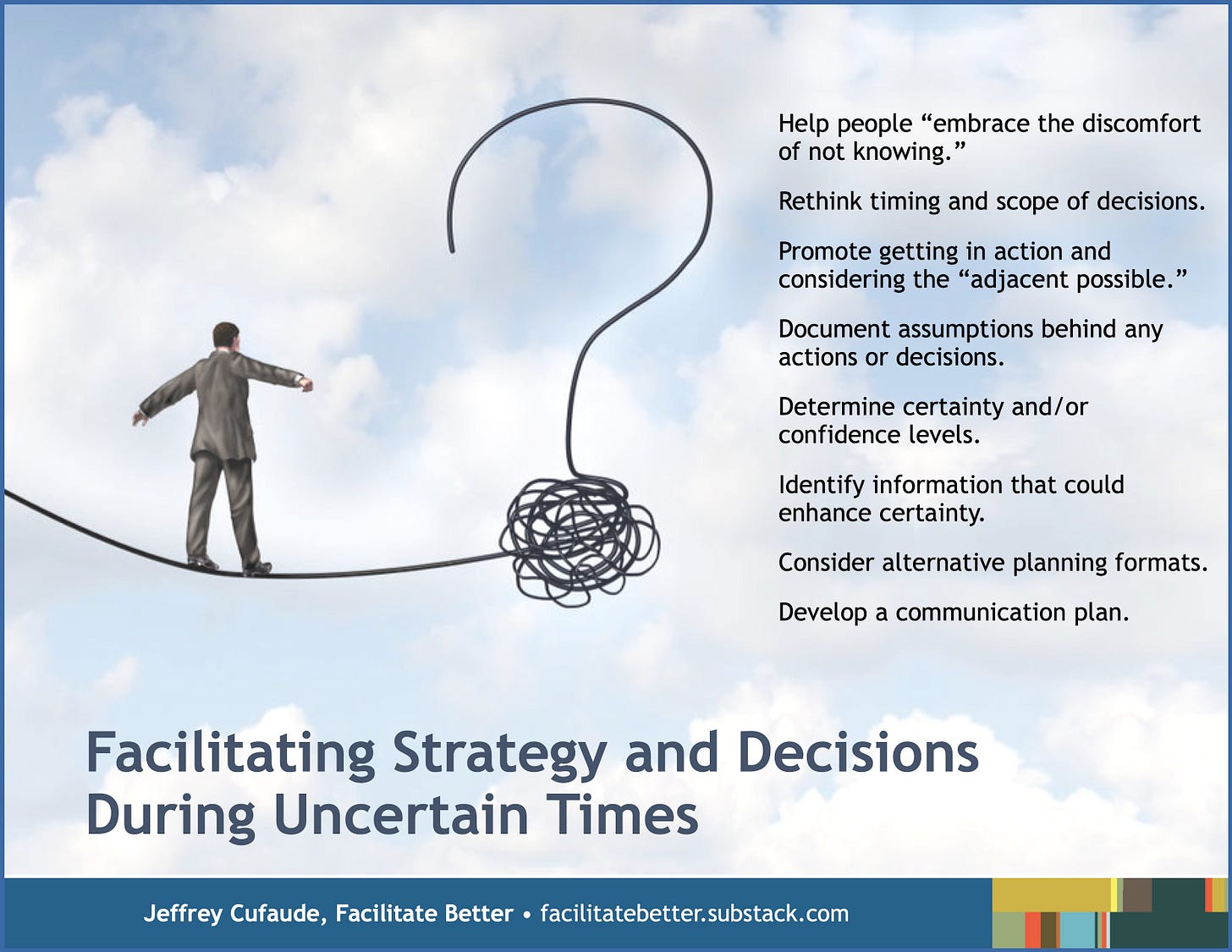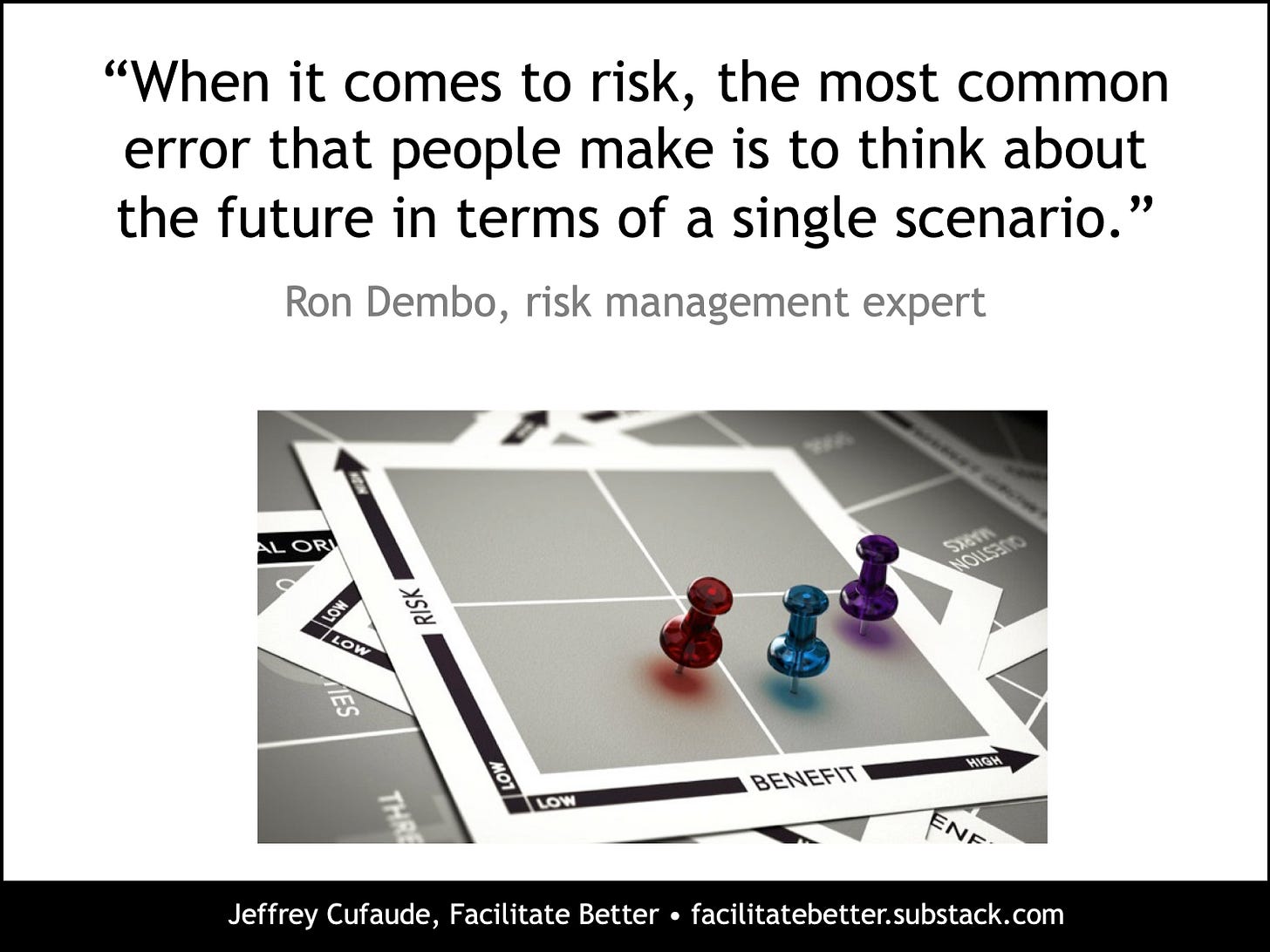Many individuals and organizations more frequently find themselves dealing with a VUCA environment (volatile, uncertain, complex, and ambiguous). Unsurprisingly, they vary in their capacity for—and comfort with—managing uncertainty and ambiguity.
As Rita McGrath notes in Seeing Around Corners, by the time a group has all the possible information to help make a decision, any choices made may have less impact. Helping groups make decisions or determine strategy while in the midst of uncertainty or with somewhat incomplete information is a common facilitator assignment. Here are some simple approaches I find make it easier to do so.
Help people “embrace the discomfort of not knowing” (Zuker and Roswell).
People may experience a variety of challenging emotions during volatile and uncertain times: anxiety, concern, stress, discomfort, and confusion. “Clearing the air” by inviting people to share their current state of mind often is a useful precursor to doing any other work together. Remember to create a conversation climate where people feel they can express themselves freely.
Not knowing can be a powerful stressor. In their article “6 Strategies for Leading Through Uncertainty,” authors Rebecca Zuker and Darin Roswell aptly suggest we embrace the discomfort of not knowing: “Move from a know-it-all to a learn-it-all mindset. You don’t need to have all the answers.”
Rethink timing and scope of decisions.
Sometimes the pressure to make a decision is self-imposed. Helping a group determine which decisions are essential might reduce its workload. In turn, this might release some of the stress group members feel.
Linda Hasenfratz, CEO of Linemar, a Canadian auto parts manufacturer, wisely notes “We like to say that the flexibility of our strategy and our business should directly correlate to the level of uncertainty.”
For any decisions determined to be necessary during volatile or uncertain conditions, a group may wish to consider shorter timeframes for assessing progress, more limited milestones, and more frequent reassessment and triage of relevant conditions.
Promote getting in action and considering the “adjacent possible.”
Groups sometimes go around in circles or get stalled in a holding pattern, unable or unwilling to make a decision until more information is available. That’s natural, but if some forward momentum is desired, effective facilitation can help provide the catalyst. I often ask: Based on the information currently available, what action would you feel confident taking right now?
Often the choice people feel comfortable making falls in the “adjacent possible,” sort of a logical next step or upgrade from current efforts. Stuart Kauffman (biologist, doctor, complex systems researcher) introduced this concept in 2002 in his book At Home in the Universe. Steven Johnson helped further popularize it some of his writing: “The adjacent possible is a kind of shadow future, hovering on the edges of the present state of things, a map of all the ways in which the present can reinvent itself …”
Document assumptions behind any actions or decisions.
I consider this to be a high impact practice for any conditions, but it can be particularly useful in a VUCA environment.
The documentation process is simple and helps groups show their work:
We see this happening …
We believe it means this or could lead to this …
As a result we’ve decided (or plan on doing) …
In other words … what, so what, now what.
If others learn of the decisions made and are uncertain about them, this documentation can help them at least understand what led to the choice. Like algebra, groups can still get partial credit for their work even if some may not agree with the final output.
The documentation also helps groups subsequently triage their decisions, reassessing the meaning they associated with the conditions that drove their choice(s), as well as determining if those conditions have changed and if further review is required. As author and consultant Brian Tracy notes, “In times of turbulence and rapid change, you have to constantly be reevaluating yourself relative to the new realities.”
Determine certainty and/or confidence levels.
Not everything is unknown or uncertain even if current turbulence makes it feel that way. Helping groups specify relevant certainty often makes it easier for them to develop strategy or make a decision.
Simple questions can again be the catalyst for this conversation: For the conditions or decisions to address, what do you know to be true? With what degree of confidence?
Assigning confidence intervals has two benefits: (1) it gives group permission to consider incomplete data or less than 100% certainty; and (2) it provides an additional benchmark to revisit during future evaluation or triage efforts.
As Edgar Schein wrote in his book Helping: How to Give, Offer and Receive Help, the best help “reveals as much data as possible to let others choose.” Effective facilitation makes it easier for more data to be revealed.
Identify information that could enhance certainty.
One productive action groups can usually take confidently is to gather more information and insight, thus reducing uncertainty and enabling decision-making. A facilitator can ask participants: What information, if it were available to you, would make it easier to formulate strategy or make a decision? From who might this data be collected or how might you gather it?
Chip and Dan Heath have suggested that “We should stop looking for experts and start looking for analogues. Chances are someone else has solved your problem already” (Fast Company, November 2009).
Effective facilitation invites thoughtful consideration of analogues and expertise beyond a group’s own profession, industry, community, or institution, as well as digging deeper into their own history for possible lessons learned:
Have we (or others) previously encountered comparable conditions?
If so, what choices were made and what were the results of those choices?
What decisions or approaches that others successfully utilized might we adopt (or adapt) for our own efforts?
Consider alternative planning formats.
I’m fond of saying that when it comes to formulating strategy or making decisions the method should match the moment. Groups navigating volatile and uncertain conditions may find increased value from doing more scenarios planning and contingency planning than the methods they use in less turbulent times.
“When it comes to risk, the most common error that people make is to think about the future in terms of a single scenario” (Ron Dembo, risk management expert).
Scenarios planning is not meant to predict the future. Instead it helps anticipate the most consequential possible futures that might unfold, the early warning signs for each, and how a group might effectively respond to any scenario that presents itself. The process can be elaborate with exhaustive environmental scanning and research or simple and streamlined drawing on existing data and resources. It depends on the resources available, the output desired, and the sense of urgency.
Helping groups develop contingency plans for handling predictable deviations from intended outcomes also is useful. People often are familiar with contingency planning from budgeting. It is not unusual to develop budgets based on anticipated income, as well as perhaps 5-10% less income or 5-10% more.
For any major decisions a group chooses to make, a facilitator might ask … are there any contingencies you want to plan for right now?
Develop a communication plan.
During uncertain conditions, individuals and organizations may communicate less frequently if they lack definitive information to share. But less information only breeds more uncertainty as individuals create their own narratives to fill the vacuum.
An important agenda item for any meeting is to identify what from the meeting to communicate, who will do so, on what timetable, and using what channels. Sometimes the message may even be “No news to report. Nothing yet decided. We’ll keep you posted. Expect another update on ____.”
Bottom line
Many individuals and organizations increasingly find themselves trying to make decisions amid uncertain or volatile conditions. Effective facilitation should make it easier for them to do so by increasing their comfort with operating amid ambiguity and by focusing their attention on the decisions that matter most.
Getting in Action
Which of the suggested practices holds the most potential for the groups in which you participate or the ones you facilitate? How might your introduce or apply them?
How else might you help others “embrace the discomfort of not knowing”? How do you manage your own feelings in these conditions?
Think of an upcoming facilitation effort or an uncertain situation you and others are currently managing. What information, if acquired and shared with all participants, might help enhance certainty?
© Facilitate Better and Jeffrey Cufaude. All rights reserved.
To affordably license this content for reprint on your site or in electronic or print communications or to contact me regarding customized facilitation skills workshops or consultations, complete this form.








Great issue!